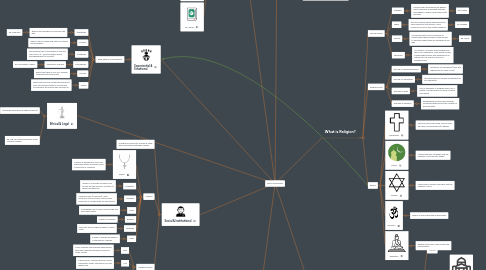
1. Narrative & Mythic
1.1. Sacred truths or stories
1.1.1. Myth
1.1.1.1. To explain or validate what is
1.1.2. Sacred History
1.1.2.1. To inspire us with tales of hero figures and larger than life events
1.1.2.1.1. Eg. The Aztec Creation Story: embodies the aspects of creation and the beginnings of the universe
1.1.3. Parable
1.1.3.1. To teach us a moral lesson or spiritual truth
1.2. Eg. Torah
1.3. Eg. Bible
1.4. Eg. Quran
2. Experiential & Emotional
2.1. Faith, beliefs, and mysticism
2.1.1. Polytheism
2.1.1.1. Belief in and worship of more than one god
2.1.1.1.1. Eg. Hinduism
2.1.2. Dualism
2.1.2.1. Belief in two co-equal and often co-eternal sacred powers
2.1.3. Pantheism
2.1.3.1. The doctrine that all that exists is God and God is all in all - God and nature being interchangeable (all is divine)
2.1.4. Monotheism
2.1.4.1. Worship of one god
2.1.4.1.1. Eg. Christianity; Islamic
2.1.5. Monism
2.1.5.1. Belief that there is only one, singular, impersonal ultimate reality
2.1.6. Deism
2.1.6.1. Belief that one God created the world but does not intervene with its functioning according to the natural laws God set up
3. Social & Institutional
3.1. A religious community follows to show their interactions with their religion
3.2. Leaders
3.2.1. Priests
3.2.1.1. Leaders in worship who carry out prescribed rituals on behalf of the community or individual
3.2.2. Monastics
3.2.2.1. monks or nuns who live apart from society as they pursue a vocation of prayer and devotion
3.2.3. Shamans
3.2.3.1. "Medicine men" (or women), most commonly found in tribal cultures, who commune or connect with the spirit world
3.2.4. Imam
3.2.4.1. A leadership role in Islam, typically the one who leads prayer
3.2.5. Brahmin
3.2.5.1. Priests in Hinduism
3.2.6. Ayatollah
3.2.6.1. The most senior religious leader in Shi'ite Islam
3.2.7. Rabbi
3.2.7.1. A sage or teacher as leader in contemporary Judaism
3.3. Religious Group
3.3.1. Sect
3.3.1.1. small, relatively young break-away groups that may separate themselves from the larger society
3.3.2. Cult
3.3.2.1. a small group, centered around a living charismatic leader; sometimes, but not always bad
3.3.3. Denomination
3.3.3.1. relatively large, well established and respected division within a religion
3.3.4. New Religious Movement
3.3.4.1. independent religions that are generally less than 100 years old
4. Ethical & Legal
4.1. Teachings about what is right and wrong
4.1.1. Duty Ethics
4.1.1.1. Immanuel Kant's categorical imperative is an example
4.1.2. Utilitarian Ethics
4.1.2.1. most concerned with the results of our actions
4.1.3. Virtue Ethics
4.1.3.1. more concerned with being a good person rather than doing good actions
4.1.4. Ethics of Divine Command
4.1.4.1. "Because God says so"
4.1.5. Natural Law Ethics
4.1.5.1. Holds that humans can know what is right and wrong based on reason
4.2. Eg. The Ten Commandments of the Christian religion
5. Doctrial & Philosophical
5.1. The teaching aspect of a religion and what causes you to believe the beliefs in one's religions
5.1.1. Four Noble Truths
5.1.1.1. 1. Suffering in the world
5.1.1.2. 2. Suffering caused by desires
5.1.1.3. 3. Can be ended or reversed
5.1.1.4. 4. Ended by Eight-Fold path
5.1.2. Trinity
5.1.2.1. Clarifies how God exemplifies three primary entities but retained as one: Father, Son, and Holy Spirit
5.2. Eg. Christian's believe in the Apostle's Creed and in the Doctrine of the Trinity.
6. Material
6.1. Physical elements of each faith or religion
6.1.1. Religious Framework
6.1.1.1. Natural
6.1.1.2. Architectural
6.1.1.2.1. Eg. Temple
6.1.1.2.2. Eg. Church
6.1.1.2.3. Eg. Synagogue
6.1.2. Religious Features
6.1.2.1. Presentational symbols
6.1.2.1.1. participate or share in that which they symbolize
6.1.2.2. Representational symbols
6.1.2.2.1. a matter of convention, where the meaning must be learned
6.2. Eg. A temple: a sacred building devoted to worship and a place to explore one's own spirituality.
7. Ritual
7.1. A formal worship practice that often re-enacts a myth
7.1.1. Life cycle ritual
7.1.1.1. Eg. Graduation
7.1.1.2. Occurs once in an individual's life
7.1.2. Calendar ritual
7.1.2.1. Eg. Thanksgiving
7.1.2.2. Can happen over and over throughout an individual's life
7.1.2.2.1. Judaism: Yom Kippur
7.1.2.2.2. Islamic's: Hajj
7.1.2.2.3. Hinduism's: Diwali
7.2. Eg. Buddhist Dance: coming together and expressing feelings by dancing, using drums, singing, costumes, etc. and celebrating a common faith together
8. What is Religion?
8.1. Sacred people
8.1.1. Prophets
8.1.1.1. Convey God's message to the people, most commonly associated with the monotheistic religions associated with Abraham
8.1.1.1.1. Eg. Moses
8.1.2. Sages
8.1.2.1. Discover wisdom within themselves and teach based on that wisdom, more commonly found in the eastern religions
8.1.2.1.1. Eg. Buddha
8.1.3. Saviors
8.1.3.1. Are perceived to be an incarnation of divine power that provides us with a path to salvation when there are obstacles in the way
8.1.3.1.1. Eg. Jesus
8.1.4. Sannyasin
8.1.4.1. In Hinduism, one who seeks release from the cycle of existence, renouncing society, leaving behind family and possessions to retreat into the forest in search of enlightenment
8.2. Religious Goal
8.2.1. the way of disciplined action
8.2.1.1. obedience to ordinances (rules and regulations for a way of life)
8.2.2. the way of meditation
8.2.2.1. turning inward for the goal of liberation or full awareness
8.2.3. The way of faith
8.2.3.1. trust in the grace of a higher being, not a matter of simple belief but more a matter of knowing
8.2.4. The way of devotion
8.2.4.1. emphasizing emotions and feelings, combined with practices as a matter of personal piety
8.3. Beliefs
8.3.1. Christianity
8.3.1.1. The belief that Jesus died, rose up from the dead, and ascended into heaven
8.3.2. Islamic
8.3.2.1. Muhammad was a prophet, and the oneness of God and his angels
8.3.3. Judaism
8.3.3.1. Maimonide's Thirteen Principles and the oneness of God
8.3.4. Hinduism
8.3.4.1. Believe in many gods and reincarnation
8.3.5. Buddhism
8.3.5.1. Believe in the Four Noble Truths and reincarnation

